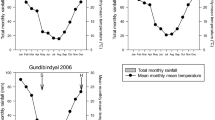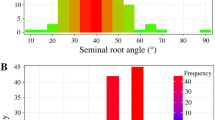Summary
Under drought conditions seminal roots may be more important than nodal roots and plants often reach maturity growing with their seminal roots only. This study was conducted to assess the differences, at an early stage of development, for seminal root characteristics and coleoptile length in three groups of barley germplasm: H. spontaneum, landraces, and modern cultivars. H. spontaneum had an average of three seminal root axes, always less than modern varieties and landraces, intermediate maximum seminal root length, and total root length similar to that of modern germplasm. Landraces did not differ from modern cultivars for number of seminal root axes, but they had the longest seminal root system. Modern cultivars had several short seminal roots. The results suggest that landraces have a more vigorous seminal root system than modern cultivars. Both landraces and H. spontaneum are important genetic resources which may contribute to specific adaptation of barley to moisture-stressed environments.
Similar content being viewed by others
References
Acevedo, E. & I. Naji, 1987. Variation in coleoptile length of barley, durum wheat and bread wheat genotypes. p. 153–156. In: Cereal Improvement Program. Annual Report for 1986. ICARDA, Aleppo, Syria.
Belford, R.K., B. Klepper & R.W. Rickman, 1987. Studies of intact shoot-root systems of field-grown winter wheat. II. Root and shoot developmental patterns as related to nitrogen fertilizer. Agron. J. 79: 310–319.
Briggs, D.E., 1978. Barley. Chapman and Hall Ltd., London, UK.
Boyer, J.S. & H.G. McPherson, 1975. Physiology of water deficits in cereal crops. Adv. Agron. 27: 1–23.
Ceccarelli, S., 1989. Increasing productivity in unfavourable conditions: philosophies, strategies, methodologies. p. 167–176. In: U. Leone, G. Rialdi & R. Vanore (Eds). Advanced Technologies for Increased Agricultural Production. CNR, Rome, Italy.
Ceccarelli, S. & S. Grando, 1987. Diversity for morphological and agronomic characters in Hordeum vulgare ssp. spontaneum C. Koch. Genet. Agr. 41: 131–142.
Ceccarelli, S., S. Grando & J.A.G. van Leur, 1987. Genetic diversity in barley landraces from Syria and Jordan. Euphytica 36: 389–405.
Ceccarelli, S., E. Acevedo & S. Grando, 1991. Breeding for yield stability in unpredictable environments: single traits, interaction between traits, and architecture of genotypes. Euphytica 56: 169–185.
Ceccarelli, S. & S. Grando, 1991. Environment of selection and type of germplasm in barley breeding for low-yielding conditions. Euphytica 57: 207–219.
Górny, A.G., 1992. Genetic variation of the root system in spring barley and oat. Treatises and Monographs No. 1, Institute of Plant Genetics, Polish Academy of Sciences, Poznan, Poland.
Gómy, A.G. & H. Patyna, 1984. The development of the root system in seven spring barley varieties under high and low soil irrigation levels. Z. Acker-und Pflanzenbau 153: 264–273.
Grando, S., 1986. Studio della variabilità in popolazioni mediterranee, coltivate e spontanee, di Hordeum vulgare e Hordeum spontaneum. PhD Thesis. University of Perugia, Italy (in Italian).
Grando, S. & S. Ceccarelli, 1991. Use of H. vulgare ssp. spontaneum in barley breeding for stress conditions. p. 526–529. In: L. Munck (Ed). Barley Genetics VI, Volume I. Proceedings of the Sixth International Barley Genetics Symposium, July 22–27, 1991, Helsingborg, Sweden.
Gregory, P.J., 1987. Development and growth of root systems in plant communities. p. 147–166. In: P.J. Gregory, J.V. Lake & D.A. Rose (Eds). Root Development and Function. Cambridge University Press.
Hurd, E.A., 1976. Plant breeding for drought resistance. p. 317–353. In: T.T. Kozlowski (Ed). Water Deficits and Plant Growth. Vol. 4. Academic Press, New York, NY.
Jaradat, A. & M. Duwayri, 1981. effect of different moisture deficits on durum wheat seed germination and seedling growth. Cereal Res. Comm. 9(1): 55–62.
Larsson, S., 1982a. Vinterhärdighet hos höstevetesorter i Sverige genom aren. Sveriges Utsä desförenings Tidskrift 92: 109–132 (in Swedish).
Larsson, S., 1982b. A simple, rapid and nondestructive screening method useful for drought resistance breeding in oat. Z. Pflanzenzüchtg 89: 206–221.
Larsson, S. & A.G. Gómy, 1988. Grain yield and drought resistance indices of oat cultivars in field rain shelter and laboratory experiments. J. Agron. and Crop Sci. 161: 277–286.
Ludlow, M.M. & R.C. Muchow, 1988. Critical evaluation of the possibilities for modifying crops for high production per unit of precipitation. p. 179–211. In: F.R. Bidinger & C. Johansen (Eds). Drought Research Priorities for the Dryland Tropics. ICRISAT, Patancheru, India.
Myhill, R.R. & C.F. Konzak, 1967. A new technique for culturing and measuring barley seedlings. Crop Sci. 7: 275–276.
Newman, P.R. & L.E. Moser, 1988. Seedling root development and morphology of cool-season and warm-season forage grasses. Crop Sci. 28: 148–151.
Parsons, L.R., 1979. Breeding for drought resistance: what plant characteristics impart resistance? HortScience 14(5): 590–593.
Passioura, J.B., 1972. The effect of root geometry on the yield of wheat growing on stored water. Aust. J. Agric. Res. 23: 745–752.
Passioura, J.B., 1977. Grain yield, harvest index, and water use of wheat. J. Aust. Inst. Agri. Sci. 42: 117–120.
Richards, R.A. & J.B. Passioura, 1981a. Seminal root morphology and water use of wheat. I. Environmental effects. Crop Sci. 21: 249–252.
Richards, R.A. & J.B. Passioura, 1981b. Seminal root morphology and water use of wheat. II. Genetic variation. Crop Sci. 21: 253–255.
Robertson, B.M., J.G. Waines & B.S. Gill, 1979. Genetic variability for seedling root numbers in wild and domesticated wheat. Crop Sci. 19: 843–847.
Troughton, A., 1962. The roots of temperate cereals (wheat, barley, oats and rye). Mimeo Publ. 2, Commonwealth Bureau of Pasture and Field Crops, Hurley, UK.
Author information
Authors and Affiliations
Rights and permissions
About this article
Cite this article
Grando, S., Ceccarelli, S. Seminal root morphology and coleoptile length in wild (Hordeum vulgare ssp. spontaneum) and cultivated (Hordeum vulgare ssp. vulgare) barley. Euphytica 86, 73–80 (1995). https://doi.org/10.1007/BF00035941
Received:
Accepted:
Issue Date:
DOI: https://doi.org/10.1007/BF00035941




